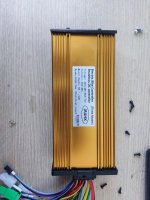There are quite a few controller modification / "overclocking" threads for both the traces and the LVC/HVC mods over the years, but you'll have to look around for them; most are in the ebike technical and motor technology subforums. There are some clever ways of reinforcing the traces, and even of modifying the current limit without touching the actual shunt, and of modifying the LVC/HVC.
Keep in mind that when you modify the shunt in any way, you are preventing the controller from knowing how much current is ever actually flowing, so it can no longer protect itself against overcurrents. Even a tiny shunt mod could result in controller damage or destruction, depending on how close to the edge they designed it--many of these are very cheaply made, and are already at the edge of what they can do.
A fair number of these shunt mods go fine, even for people that have virtually bypassed the shunt entirely, but it depends on the controller's design and what the bean counters decided to do to that design before manufacturing it (reducing the cost of parts by using cheaper ones with lower specs, leaving out protection parts, etc).
You'll only know what happens after you try it out.

FWIW, I didn't bypass my shunt on a generic 15FET I have on the SB Cruiser trike's right rear wheel, I just added another out of a dead controller in parallel with the existing ones, to get (in theory) about 1/3 more power out of it. It has been running for years without blowing up, but similar mods to other controllers haven't worked out so well. The Grinfineon on the left rear wheel is unmodified. Just in case, I keep a spare controller bolted to the bottom of the trike and already wired in except for the power and phase wires; if something does blow up I can just plug it in in place of the blown one and keep riding.
Regarding the LVC mod, if you're already using a battery that's matched to the controller's voltage range, then bypassing the LVC will be hard on the battery, especially if you force the system to depend on the BMS to save the battery from damage every time, and even worse if you have no BMS or the BMS has failed stuck on (not uncommon) so there is no cell protection against overdischarge damage.
Same is also true of the current--if the shunt mod exceeds what the cells can really handle (not necessarily what they're sold as being able to, which is often an "overstatement", to be polite), they will sag in voltage a lot, age faster, and heat up more, and possibly be damaged.
Damaged cells from either of those conditions can lead to fires...it's rare, but it does happen, and you can't know the damage is present until the fire starts.





